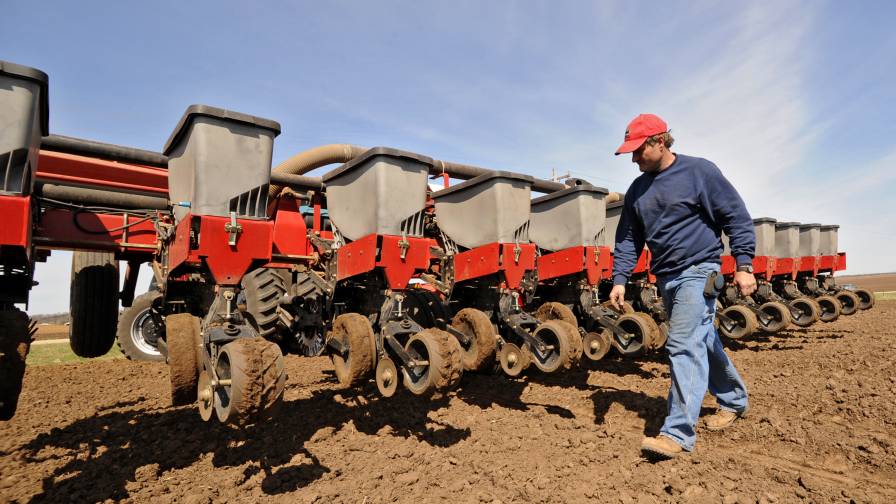Spring Fertility Outlook: Ag Retailers Approach 2024 Season with ‘Guarded Optimism’

Most ag retailers believe 2024 has the potential to be a strong season for crop nutrients — providing a few “wild cards” don’t get played. Photo: CHS
To many that follow the ups and downs of crop inputs in the agricultural marketplace, the fertilizer category was hard to read correctly during 2023. While the category’s sales among the nation’s top ag retailers were off significantly — down $1 billion year-over-year vs. 2022’s totals to $22.4 billion — most industry suppliers indicated that usage rates remained relatively steady compared with the previous growing season.
Most observers chalked this disparity to significant price drops depressing revenues but not demand at the field level among grower-customers.
So, with a somewhat mixed market picture from 2023 behind agriculture, what does the 2024 spring season hold for the fertilizer industry? In a few words, “guarded optimism” come to mind.
“The fall 2023 and 2024 fertilizer season started off on a positive note, seeing fertilizer input prices soften from the two years prior,” says Andrew Scholtz, Agronomy Sales Representative at CHS, Inver Grove Heights, MN. “The timid early winter weather made for a productive fall fertilizer season. It created optimal soil conditions for many forms of tillage practices. Both aspects were ideal for producers to set the stage for a successful start to plant in 2024.”
However, other ag retailers aren’t quite as certain for the 2024 spring fertility outlook just yet. In fact, according to Joey Caldwell, Senior Vice President, Retail at GreenPoint Ag, Decatur, AL, his company has recently altered its view on the upcoming growing season somewhat.
“We had forecasted volume increases earlier but now suspect a shift more to soybean and peanut acres, which will have a softer impact on overall demand,” says Caldwell. “The price of corn will be the driver — and yes, even in the South, we find that to be true more so every year.”
George Secor, President/CEO at Sunrise Cooperative, Fremont, OH, says his company is even more reserved regarding a strong spring fertility outlook. “I am very neutral so far as fertilizer application goes for 2024,” says Secor. “Growers had plenty of carryover money from 2022 and our fall application was very good, but I am very concerned when we really study budgets what will happen in 2024. Most budgets here in the Eastern Corn Belt will be in the red when we plug in $5.06 corn and $12.63 soybeans.”
It’s All About Prices
As always, prices — both recent and current — are the keys to this outlook from Secor. “As we look back, the past two years have been almost polar opposite kind of years,” he observes. “2022 prices ran up almost all year long. On the other hand, in 2023, it seemed like whenever retailers stepped up and bought something, it declined in value. Here at Sunrise, we just have to keep playing our game. We will know what our position is on a regular basis. We will adjust our retail prices up and down as the market moves, keeping ourselves competitive in the marketplace at all times. Finally, we will continue to help growers lock in fertilizer inputs for future years’ crops today. Growers are proactive about managing risk for the crops they are growing not only in 2024 but they want to manage risk for the 2025 crops as well.”
In addition to higher-than-normal prices, the other major issue facing the fertilizer sector recently has been tied to logistics. “Logistics has been the largest challenge the last few years and this is holding true for the 2023-24 fertilizer season,” says CHS’ Scholtz. “From a global fertilizer market standpoint, China’s export controls, Brazil’s conservative fertilizer usage, and instability in the Red Sea are a few of the contributing factors that may influence future fertilizer demand, pricing, and supply.”

CHS has established a strong infrastructure with its customers in mind to make sure the company can meet grower-customers’ needs and those of their crops. Photo: CHS
To address this, he adds, CHS has established a strong infrastructure with its customers in mind to make sure the company can meet grower-customers’ needs and those of their crops. Furthermore, Schlotz believes ag retailers in general will adjust to ongoing logistics challenges accordingly.
“In my opinion, retailers will consider factors such as fertilizer shipping logistics or alternatives to make sure supply is in place for high-demand periods,” he says. “They will also consider storage space, making sure they’re properly utilizing storage.”
In terms of which macronutrients can expect to see the most demand during the spring 2024 application season, GreenPoint Ag’s Caldwell has high hopes for potassium. “Even with a shift to soybeans and peanuts, we need to replace some potassium where yields have been favorable,” he says.
Meanwhile, Sunrise’s Secor is optimistic that several crop nutrient sectors will see demand increases for the 2024 spring season. “It looks like 2024 will be a good year for potash and sulfur,” he says. “We are seeing response all over the place to sulfur. Farmers are using it on nearly every crop every year right now and we foresee sulfur rates and volumes to continue going up. Nitrogen should be fairly stable for us as long as we do not see a big move in corn acreage, which, traditionally, we really do not see change that much at all.”
Wild Cards to Watch
Of course, each and every growing season, there is always the potential for the unexpected to occur that can change market dynamics literally in a heartbeat. At least a handful of these so-called “black swan events” or wild cards tend to pop up on a semi-regular basis.
In 2024, one that bears watching is rising interest rates, according to Secor. “When using 8%-plus interest rates, retailers must be very careful that if they are going to take positions, the cost to carry those positions is going to be very high and we have to make sure we capture those interest charges back,” he says. “This is a wild card we can manage. The system feels like it ended the spring of 2023 very empty, and I am just not really sure with high interest rates how well the system has been filled back up.”
Speaking of unmanageable wild cards, Secor cites such factors as weather and low water levels on the Mississippi River, which have disrupted one of the major transportation channels utilized by crop nutrient suppliers and ag retailers. “I really have no way to control these, so we will just have to deal with them as they come at us,” he says.
CHS’ Scholtz also brings up another potential wild card that the agricultural industry has no control over as a danger in 2024 — global conflict. “Global import and export relationships, weather conditions in areas that directly compete with the U.S. market, and the conflicts in the Red Sea are a few wild card factors that come to mind,” he says. “If the supply of fertilizer is restricted or improved by a shift in any of those few factors, we will see fertilizer prices react accordingly.”






